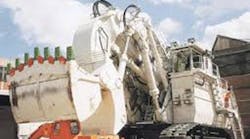During a seminar I presented recently, one of the attendees, a maintenance manager for a large open-cut mining operation, mentioned that he was considering upgrading the filtration on their fleet of hydraulic mining shovels - to achieve a higher level of oil cleanliness.
There's lots of documented evidence to suggest that increasing hydraulic oil cleanliness increases the service life of hydraulic components - all other things equal. Whether such an initiative would yield an acceptable return on the investment required, for the machines in question depends on a number of variables, which I don't have room to go into here. But this got me thinking about a bigger issue.
The maintenance routines I teach in my books and training programs are about equipping people with the knowledge the need today to optimize the reliability and service life of the hydraulic equipment they have right now. And that's fair enough - it's rarely helpful and not very instructive to tell someone what they should have done yesterday. With this is mind, one of the exercises we do during the seminar is carry out a maintenance and reliability audit on an existing hydraulic machine.
Even though equipment design and equipment maintenance are often viewed in isolation, the reality is, certain aspects of hydraulic machine design have a significant impact on the machine's operating cost and reliability, and ultimately, its life-of-ownership cost.
Over lunch, the same maintenance manager mentioned that his mine is starting to think about the replacement of their aging fleet of hydraulic shovels. And it occurred to me, the best time to carry out a maintenance and reliability audit on a piece of hydraulic equipment is BEFORE you buy it.
By starting with the end in mind, you get the maintenance and reliability outcomes you desire - before the machine even gets delivered. For example:
You specify the contamination control targets you want to achieve based on your reliability objectives for the piece of equipment. And instruct the manufacturer to deliver the machine appropriately equipped to achieve these targets.
Based on the weight and viscosity index of the hydraulic oil you plan to use, you determine the minimum viscosity and therefore the maximum temperature you want the machine to operate at. And instruct the manufacturer to deliver the machine equipped with the necessary cooling capacity, based on ambient temperatures at your location. Rather than accepting hydraulic system operating temperatures dictated by the machine's 'design' cooling capacity - as is the norm.
And if you don't think oil viscosity/temperature is this important - you're mistaken. Lubrication failure resulting from low oil viscosity is one of the biggest causes of premature failure in hydraulic components. If you're not on top of this issue it could be costing you big.
And we could continue by specifying things like flooded inlet for all pumps and so on. But you get the idea.
So the next time you or the company you work for are looking to acquire hydraulic equipment, begin with the end in mind. Define your maintenance and reliability objectives in advance and make them an integral part of your equipment selection process. Failing to do so could be a costly mistake in the long run. And to discover six other costly mistakes you want to be sure to avoid with your hydraulic equipment, get "Six Costly Mistakes Most Hydraulics Users Make... And How You Can Avoid Them!" available for FREE download here.

Continue Reading
Continue Reading
BOOK 2, CHAPTER 12: Fluid Motor Circuits
March 18, 2009
Motor leakage variations
Oct. 18, 2006
Sponsored Recommendations
Sponsored Recommendations
How Variable Volume Pumps Work
Feb. 6, 2024
What is a Check Valve and How Does it Work?
Feb. 6, 2024
